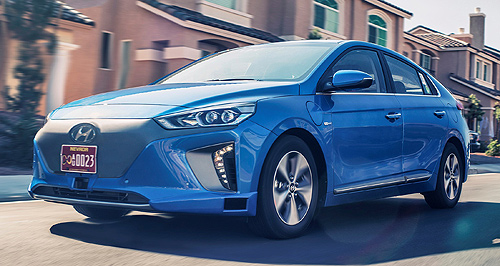Make / Model Search
Future models - Hyundai - IONIQ - Autonomous conceptHyundai keeps it simple on driverless carsNo hands: Hyundai’s autonomous Ioniq prototype hides the radar sensors in the bumper so it does not look like “a high-school science project”. Affordability a key goal for Hyundai on self-driving cars of the futureGallery Click to see larger images 17 Nov 2016 HYUNDAI has revealed it is working on an affordable autonomous vehicle guidance system to ensure the technology is within reach of average buyers of its future cars. Revealing a self-driving prototype of its Ioniq electric vehicle at the Los Angeles motor show today, the Korean company said its goal was to keep its in-house-developed system as simple as possible by integrating current production car aids such as adaptive cruise control radar and lane-keep assist cameras and integrating them with bumper-mounted LiDAR (Light Detection and Ranging) sensors. It said it was also developing its own autonomous vehicle operating system that uses “a lot less computing power”. “This will result in a low-cost platform which can be installed in future Hyundai models the average consumer can afford,” the company said in a statement released on line. Hyundai said it was planning to show off two autonomous Ioniqs at the Consumer Electronics Show (CES) in Las Vegas in January when they will take to city streets to demonstrate the technology in real-world conditions that could include pedestrians, stop lights and stop signs, road construction, road blocks, speed bumps, dogs off the leash, children at play and uncontrolled intersections. Hyundai said its autonomous prototypes – three of which are on test at its proving ground in South Korea – were the first to conceal the LiDAR sensors in the front bumper instead of mounting them on the roof, “enabling it to look like any other car on the road and not a high school science project”. A diagram of the detection devices shows three forward-looking radars, from long-range able to detect objects up to 200 metres away, to a shorter-range version that looks out to 60 metres, but much wider. A three-camera array behind the windscreen detects pedestrians, lane markings and traffic signals, while GPS locates the vehicle. Huyundai’s own MnSoft maps helps to guide the vehicle down the centre of lanes and around curves, while blind spot detectors control lane changes. The conventional steering-wheel equipped Ioniq is being rolled out around the world in three forms, hybrid, plug-in hybrid and all electric. It was not immediately clear which version the autonomous Ioniq at the LA show is based on, but most likely the full electric variant. Hyundai Motor Company Australia plans to launch the Ioniq in Australia next year, but it has not said which versions it will adopt.  Read more3rd of November 2016  Hyundai Ioniq hits 254km/h in record attemptNitrous boosted Hyundai Ioniq sets 254km/h production hybrid land speed recordAll future models Alfa Romeo Alfa Romeo Abarth Abarth Alpine Alpine Alpina Alpina Audi Audi Aston Martin Aston Martin BMW BMW Bentley Bentley Chery Chery Brabham Brabham Chrysler Chrysler Chevrolet Chevrolet Cupra Cupra Citroen Citroen DS DS Dodge Dodge Fiat Fiat Ferrari Ferrari Foton Foton Ford Ford Great Wall Great Wall FPV FPV Haval Haval GWM GWM Honda Honda Holden Holden Hummer Hummer HSV HSV Infiniti Infiniti Hyundai Hyundai Jaguar Jaguar Isuzu Isuzu Kia Kia Jeep Jeep Land Rover Land Rover Lamborghini Lamborghini Lexus Lexus LDV LDV Mahindra Mahindra Lotus Lotus Mazda Mazda Maserati Maserati Mercedes-AMG Mercedes-AMG McLaren McLaren MG MG Mercedes-Benz Mercedes-Benz Mitsubishi Mitsubishi Mini Mini Opel Opel Nissan Nissan Peugeot Peugeot Pagani Pagani Proton Proton Porsche Porsche Renault Renault Ram Ram Rover Rover Rolls-Royce Rolls-Royce Skoda Skoda Saab Saab SsangYong SsangYong Smart Smart Suzuki Suzuki Subaru Subaru Toyota Toyota Tesla Tesla Volvo VolvoMotor industry news |
Click to shareHyundai modelsResearch Hyundai All future models Alfa Romeo Alfa Romeo Abarth Abarth Alpine Alpine Alpina Alpina Audi Audi Aston Martin Aston Martin BMW BMW Bentley Bentley Chery Chery Brabham Brabham Chrysler Chrysler Chevrolet Chevrolet Cupra Cupra Citroen Citroen DS DS Dodge Dodge Fiat Fiat Ferrari Ferrari Foton Foton Ford Ford Great Wall Great Wall FPV FPV Haval Haval GWM GWM Honda Honda Holden Holden Hummer Hummer HSV HSV Infiniti Infiniti Hyundai Hyundai Jaguar Jaguar Isuzu Isuzu Kia Kia Jeep Jeep Land Rover Land Rover Lamborghini Lamborghini Lexus Lexus LDV LDV Mahindra Mahindra Lotus Lotus Mazda Mazda Maserati Maserati Mercedes-AMG Mercedes-AMG McLaren McLaren MG MG Mercedes-Benz Mercedes-Benz Mitsubishi Mitsubishi Mini Mini Opel Opel Nissan Nissan Peugeot Peugeot Pagani Pagani Proton Proton Porsche Porsche Renault Renault Ram Ram Rover Rover Rolls-Royce Rolls-Royce Skoda Skoda Saab Saab SsangYong SsangYong Smart Smart Suzuki Suzuki Subaru Subaru Toyota Toyota Tesla Tesla Volvo VolvoMotor industry news |























Facebook Twitter Instagram